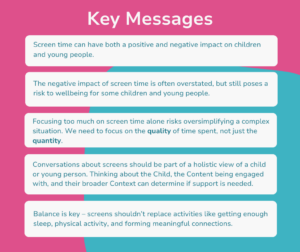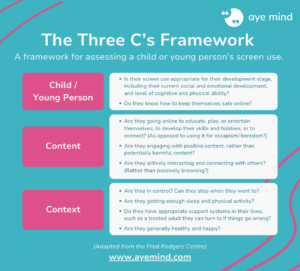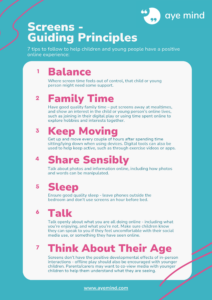Screen time and mental health: What does the evidence say?
There is an ongoing and heated debate around the impact that “screen time” is having on children and young people’s mental health and wellbeing. This debate is being amplified across media outlets, which often claim that social media is causing a youth mental health crisis. You don’t have to go far to find alarming headlines like “Smartphones and social media are destroying children’s mental health”. With worrying titles like this, it’s no wonder that people are concerned about how much time children and young people are spending on screens.
This blog takes a look at what the evidence actually says about screen time and its impact on children and young people’s mental health. It provides a framework for determining the quality of time spent online and includes some resources for helping children and young people find a good balance.

Firstly, what is screen time?
Definitions of screen time vary, but in general screen time refers to time spent using a device such as a computer, television, mobile phone, or a games console.
How much time are children and young people spending on screens?
Evidence shows us that young people are spending a substantial amount of time online. In Scotland in 2022, school-aged children aged 11-15 years old were spending an average of:
- 3.0 hours gaming
- 8 hours on social media
- 4 hours watching TV
- 2 hours browsing the internet (HBSC Survey, 2022)
Those aged 18-24 are also reported to spend an average of 5 hours and 6 minutes online each day (Ofcom, 2022). Young people often use many screens at once, known as ‘multi-screening’, and they may therefore be doing many of these activities at the same time.
So, what exactly is the impact of screen time on children and young people’s mental health?
The simple answer is that we can’t say for sure. This is because the evidence is inconsistent and numerous studies have revealed mixed findings (Tang, 2021; Santos, 2023; Stiglic, 2019).
Benefits of screen time
Much of the literature around screen time and its impacts on mental health and wellbeing has focused on its potential harms. There is a growing body of evidence, however, which points to the range of benefits to children and young people. This includes giving them space to socialise, build relationships and connect with others, play, be entertained, and get social support. This has important benefits for their self-esteem, self-identity, life satisfaction, and has been shown to reduce social anxiety and loneliness (Zhou and Cheng, 2022).
It also gives young people opportunities for their development and learning – such as being able to search online for information, do their homework, learn new concepts, or develop their digital literacy and skills.
Potential harms of screen time
In contrast to the limited studies exploring the benefits of screen time, there have been numerous studies looking at the potential harms. Despite the sheer volume of research into this topic, the findings are often mixed and are not typically high-quality evidence. Some have shown screen time does have a negative effect, others show positive benefits to wellbeing, and others show no significant associations at all. As a result, there currently is no scientific consensus on screen time’s impact.
Several systematic reviews have shown us that the clearest relationship is the impact that screen time can have on depression, with higher screen time being associated with higher rates of depression (Tang, 2021; Stiglic, 2019; Santos, 2023). In terms of how big an effect screen time has on depression, however, it is relatively small.
Some studies have also found associations between screen time and anxiety, self-esteem, and other symptoms such as distress and quality of life. These associations, however, are much weaker (Tang, 2021; Stiglic, 2019).
Is “How much screen time?” the right question?
One major issue that has been given as a reason for why the current debate around screen time is so complex is that we focus too heavily on time spent when we think about how we are using technology (Orben, 2020). Modern technologies are so diverse, that even if two users are spending exactly the same time on screens, their experience will be very different. Instinctively we know that 20 minutes spent online chatting to a grandparent is not the same as 20 minutes spent looking at self-harm images (Orben, 2020). We, therefore, cannot expect the mental health impacts to be the same.
As a result of the mixed evidence we have seen, guidance for families in the UK around screen time from the likes of the Royal College of Paediatrics and Child Health and the UK Chief Medical Officers have resisted providing a cut-off point when it comes to the ideal amount of screen time (RCPCH, 2019; Department of Health and Social Care, 2019).
Instead, we must remember that the effects of any technology use will depend on the person, their history, motivations, the content they are engaging with, and much more. We should therefore try to avoid framing conversations about screen time as simple questions like “How much is the right amount?” and “What is the right limit/ban on screen use?”. This is because these questions risk oversimplifying a very complex situation to a basic time estimate. This in turn does not allow us to develop a meaningful understanding or suggest appropriate interventions.
What should we be focusing on when it comes to screens then?
Although the evidence isn’t clear cut, it does still show screens can impact some children and young people’s wellbeing, and we know that they can encounter a range of harms online. Rather than ignoring screens altogether, we need to focus our efforts on the quality of the time that children and young people are spending online, rather than solely the quantity of it.
The Three C’s Framework (Child or young person, Content, Context) is a useful starting point for guiding a more holistic and individualised view of a particular child or young person and how they are using screens (Adapted from Fred Rodgers Centre, 2012). These questions can help to identify whether an individual child or young person might require support with screens:

If the answers to most of these questions are “yes”, then fears around screens might not be founded. Where answers are more or less “no”, then parents and carers might want to consider taking further action. This should be tailored to the needs of that individual child or young person to address problematic use and help to put scaffolding in place so they can keep themselves safe online. We have listed some resources at the end of this blog that can help do that.
Some guiding principles
In addition to the above framework, we have combined the key recommendations from a range of guidance documents that have been published around screen use (Department of Health and Social Care; RCPCH, American Academy of Paediatrics). These guiding principles can be followed to help children and young people have a positive online experience and prevent any negative impacts from screens:

Parents, carers, and adults can be great role models for children and young people around their screen use, so where possible, it’s important that we try to lead by example.
Key takeaways
This article has debunked some of the myths that exist around screen time. There currently is not enough consistent, high-quality evidence to back up the statements that screen time is causing a youth mental health crisis. Therefore, rather than heavily limiting screen time or banning it altogether, we need a more balanced response that is proportionate to the potential harms. To help us do this, we need to be looking holistically at the child or young person. We can use frameworks like the Three C’s Framework to support us in determining whether a child or young person needs support, and we can also follow a general set of guiding principles and ‘good’ digital habits to keep us on track. In doing so, we can help children and young people to thrive offline and online.
Helpful resources
We know that when it comes to screens, getting the balance right can be challenging. To help, we have listed below a range of resources that could be used to support children and young people to have good quality screen time and a safe online experience:
- Balancing Screen Time: Creating a Balanced Digital Diet with Screen Time Tips – A guide from Internet Matters to help children develop healthy online habits and have a good digital diet to help them thrive both online and offline.
- Common Sense Media – Reviews, advice, and age appropriate recommendations for games, apps, films, and more.
- Family Agreement – A family agreement template created by Childline that offers a series of prompts for things to consider when discussing how everyone should be using the internet. It helps to set clear expectations for positive and safe internet use.
- Internet Matters Parental Controls – Guides to help set up the right controls and privacy settings on digital technologies and tools to help children and young people have a safer online experience.
- Let’s Talk About Life Online – Advice and conversation starters from Childline for helping a child stay safe online.
- Mind Yer Time – Designed by children and young people from the Children’s Parliament and the Scottish Youth Parliament, Mind Yer Time is a resource that has been created to support people to use their screen time positively. This includes tips, stories, and information for children and young people about screen use.
- ProjectEVOLVE – Host a range of resources and curriculum material for conversations around screen time and digital wellbeing.

Share this blog
